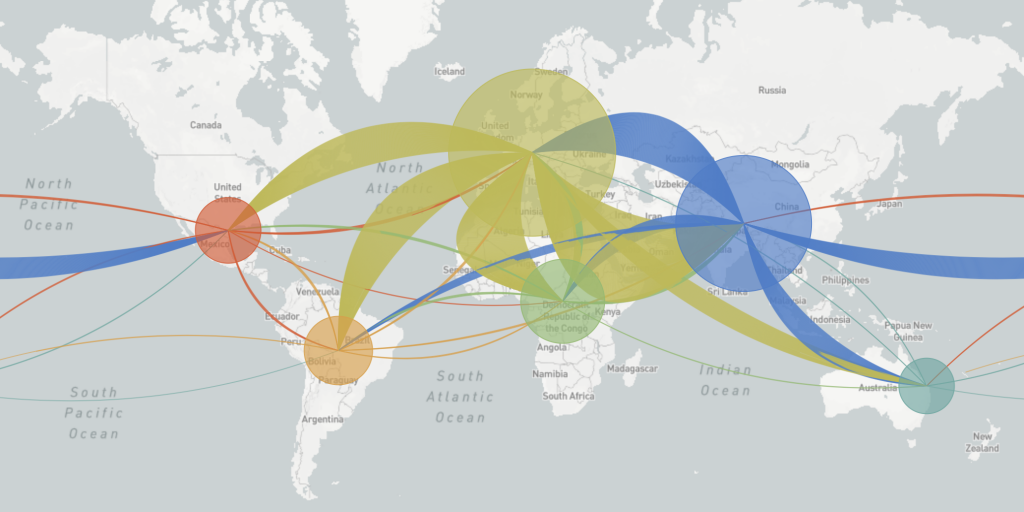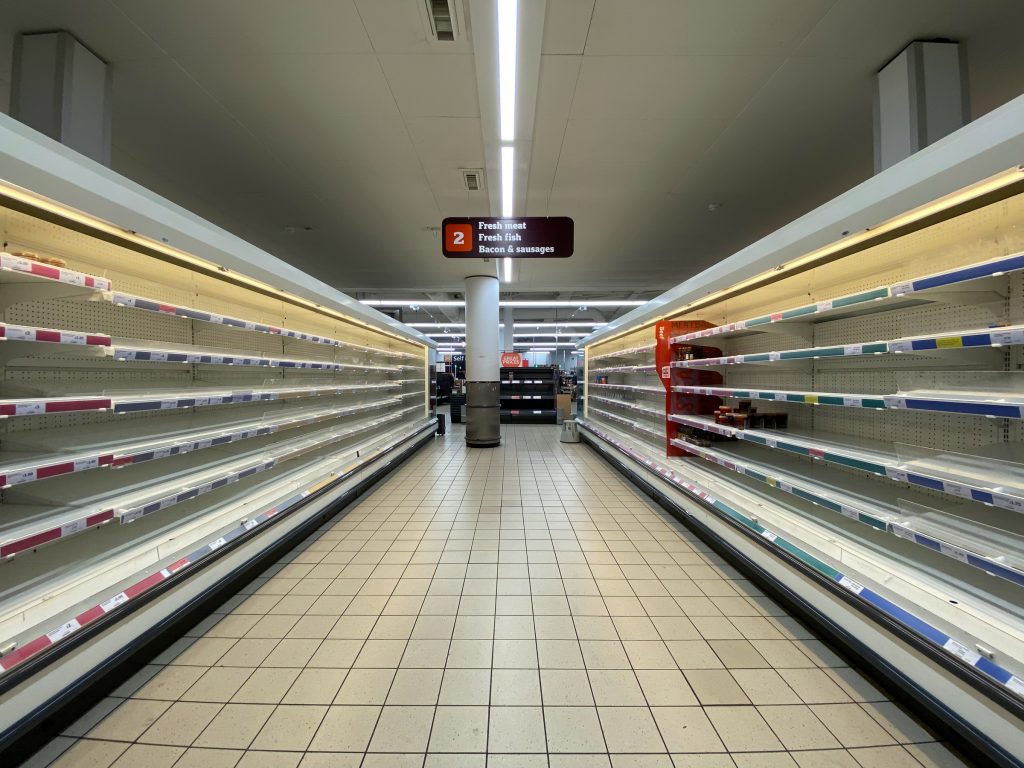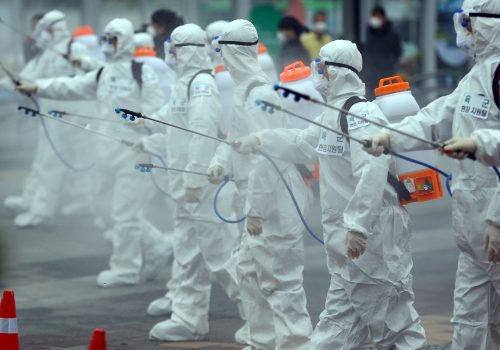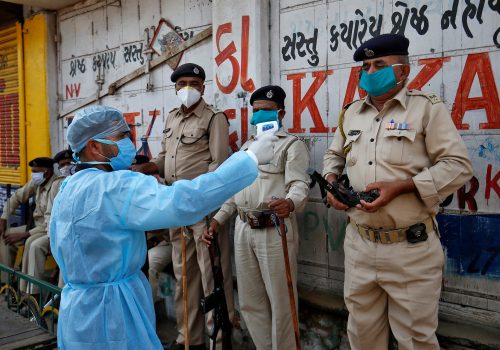This article is part of a longer paper—What world post-COVID-19? Three scenarios. Download the full paper using the button below.
As of mid-May, there were 4.62 million confirmed cases of COVID-19 with more than 300,000 known deaths from the disease worldwide. The United States accounted for 30 percent of the average global daily deaths. In recent weeks, Latin America and the Caribbean accounted for 25 percent of all global daily deaths, fueled by the growing outbreak in Brazil.1“Coronavirus Tracked: The Latest Figures As Countries Fight to Contain the Pandemic,” Financial Times, accessed May 27, 2020, https://www.ft.com/content/a26fbf7e-48f8-11ea-aeb3-955839e06441. Russia and India had also become COVID-19 hot spots in April and May, respectively. The number of global deaths from the coronavirus is almost certainly higher. In some countries, mortality has been as much as 50 percent higher than the historical average.
If the coronavirus infected half the world’s current population over the course of a year with a 1 percent fatality rate, the death toll would be 35 million. By comparison, the Spanish flu infected an estimated 500 million people and killed 50 million worldwide in 1918-19.
As the coronavirus spreads to the developing world, there is increased worry about higher death tolls because of the more fragile health systems in many of these countries. Hugo López-Gatell, Mexico’s coronavirus tsar, “has admitted [in late April] that the true infection level is at least eight times higher.”2Andres Schipani and Jude Webber, “Latin American Gravediggers Fear Virus Death Toll Higher Than Admitted,” Financial Times, April 20, 2020, https://www.ft.com/content/7b46b8c3-b395-45ba-af68-50280cfeed47. As of mid-May, there were almost 50,000 confirmed COVID-19 cases in Mexico. India was leading Asia with almost 100,000 cases. There are confirmed reports of the virus spreading to a refugee camp in Bangladesh that houses nearly one million Rohingya.3“Coronavirus Confirmed in Bangladesh Refugee Camp Housing Nearly 1 Million Rohingya,” ABC News, May 15, 2020, https://www.abc.net.au/news/2020-05-15/bangladesh-says-coronavirus-detected-in-rohingya-refugee-camp/12252114. Refugees in the camp do not have access to enough soap and clean water to protect themselves against the contagion.4Ibid. In Pakistan, the public health system is ill-equipped to handle any crisis. In Karachi, for example, there are only 600 intensive care unit (ICU) beds for the city’s population of 20 million.
Pakistan’s public health system is extremely ill-equipped to handle any crisis; it has only 600 ICU beds for the whole Karachi population of 20 million.

This phylogeny map shows evolutionary relationships of SARS-CoV-2 viruses from the ongoing novel coronavirus COVID-19 pandemic. This phylogeny shows an initial emergence in Wuhan, China, in Nov-Dec 2019, followed by sustained human-to-human transmission at a global level. The map shows clear genetic relationships, though the transmission patterns are inferred and specific transmission dates are still uncertain.
Source: Nextstrain.org
As the coronavirus leaves a mounting death toll in its wake, we may not be in the clear until a vaccine is created and widely distributed. To avoid a reoccurrence, countries will need to keep their social distancing measures in place and lockdowns enforced where hot spots reappear. It will be important not to ease up too soon on all restrictions, given the still lingering strains of the virus. Testing will need to continue in order to discover who might be a carrier despite showing no symptoms. Based on the Vò Euganeo experiment—the small village in Veneto, Italy, where all 3,000 inhabitants were tested twice—up to 50 percent of those infected could be asymptomatic, which explains the larger spread than we would have seen from just the confirmed cases. Only when the public has been properly vaccinated will the virus be completely conquered.
We must expect that the coronavirus will continue to mutate, potentially making it harder to develop a vaccine. RNA-based viruses like the coronavirus tend to mutate about 100 times faster than DNA-based ones, although the coronavirus will not mutate as quickly as influenza viruses.5Tomas Pueyo, “Coronavirus: The Hammer and the Dance,” Medium, March 19, 2020, https://medium.com/@tomaspueyo/coronavirus-the-hammer-and-thedance-be9337092b56. Nevertheless, the general notion prevails: the more people are infected, the more of a chance for a mutation. In late April, a Los Alamos National Laboratory study found there were 14 strains of the coronavirus with some proving to be more infectious than others.6Elizabeth Weise, “Many Coronavirus Mutations Are Circling the Globe, But We Don’t Know If Any Are More Dangerous,” USA Today, May 5, 2020, https://www.usatoday.com/story/news/health/2020/05/05/coronavirus-strains-mutating-some-more-dangerous-than-others/3085752001/.
We must be prepared for the coronavirus to become a “recurring fact of life,” like the ordinary flu, but much deadlier.
Systemic Shock
The pandemic is not just a global health crisis.
In its wake, the global economy lies in tatters, leaving open the question of how and when countries and regions will be able to start a real recovery, if governments must maintain social distancing and other restrictions for some time.
We all hope for a quick V-shaped return to the status quo ante, but there are disturbing signs that the recovery will be difficult and extended, causing substantial damage to the social and political fabric in many regions.
The United Nations’ World Food Program has warned that “the number of people facing acute food insecurity could double in 2020 from the year before, to 265 million. The pandemic and lockdown measures combined with rising unemployment and limited access to food could lead to violence and conflict.”7FT reporters, “Warnings of Unrest Mount As Coronavirus Hits Food Availability,” Financial Times, April 21, 2020, https://www.ft.com/content/443b74f7-e9f2-412f-b9d6-241168cc1710. Even in advanced economies, there are growing fears of malnutrition. In the United Kingdom, three million people have had someone in their household going without food, according to a Food Foundation survey.8Bethan Staton and Judith Evans, “Three Million Go Hungry in UK Because of Lockdown,” Financial Times, April 10, 2020, https://www.ft.com/content/e5061be6-2978-4c0b-aa68-f372a2526826. In the United States, food banks have seen long lines of people relying on free food to survive.
Without a swift global economic recovery, for example, the gains we have seen in the expansion of a global middle class and poverty reduction could be sacrificed. In rich countries where the middle class has already been under pressure, a return of high unemployment and income stagnation could bolster populism and widespread discontent.
The Spanish flu, which hugely added to the death toll from World War I, was a factor in ending the second phase of globalization and sparking conflict in the interwar period.
From a dream of making the world safe for democracy, the post-World War I era ended up leading to the rise of fascism and communism in Europe. The United States turned its back on the world, electing not to join the League of Nations and passing draconian legislation that largely ended immigration.
Will there be a repeat of history in the post-COVID-19 era?
Even before the pandemic started, there were ample signs of deglobalization, rising anti-immigration sentiment, and great power competition. Will the coronavirus, therefore, tip the balance against global cooperation and multilateralism and instead strengthen the forces of nationalism, populism, and authoritarianism?
As in the interwar period, a lack of global cooperation at this critical moment will worsen the ongoing health crisis and make a rapid economic recovery impossible.
The Homeland Under Threat
Since the beginning of May 2020, the US curve of new COVID-19 cases has been flattening.
From a high of more than 36,000 new cases, it was trending downwards to between 21,000 to 27,000 new cases per day in late May.9Coronavirus Resource Center, Johns Hopkins University & Medicine, “New Cases of COVID-19 In World Countries,” https://coronavirus.jhu.edu/data/new-cases. When the tri-state area around New York City is “excluded from the national case count,” the number of daily cases is rising, however.10Aria Bendix, “The US is Reopening Too Soon. One Chart Shows Cases Are Still on the Rise Outside the Tristate Area.” Business Insider, May 7, 2020, https://www.businessinsider.com/states-easing-lockdown-restrictions-premature-us-cases-rising-2020-5. With more than 30 US states easing lockdowns, medical experts worry about a spike in new cases, particularly in rural and other areas lacking in health care access. “Large parts of the South and Appalachia are especially vulnerable,” according to a health-risk index identifying counties with high rates of underlying conditions such as diabetes, high blood pressure, obesity, heart disease, and chronic lung disease.11Nadja Popovich, Anjali Singhvi, and Matthew Conlen, “Where Chronic Health Conditions and Coronavirus Could Collide,” New York Times, May 18, 2020, https://www.nytimes.com/interactive/2020/05/18/us/coronavirus-underlying-conditions.html?action=click&module=Spotlight&pgtype=Homepage. 12Ibid. These conditions have been known to increase the risk of anyone contracting the disease becoming severely ill.13Ibid.
So far, the “most vulnerable and disadvantaged populations in the US” have been the hardest hit14Coronavirus Resource Center, Johns Hopkins University & Medicine, “Racial Data Transparency,” https://coronavirus.jhu.edu/data/racial-data-transparency. While there is still only limited data, Johns Hopkins medical researchers have found that “black Americans and other historically disadvantaged groups are experiencing infection and death rates that are disproportionately high for their share of the total population.”15Ibid. Asian Americans and Latinx Americans also show elevated impacts in some regions.16Ibid. These groups are also overrepresented in the essential jobs in health care, food supply, and transportation where they are more likely to be exposed to the virus.17Coronavirus Resource Center, Johns Hopkins University & Medicine, “Racial.”
Slow Recovery
Any economic recovery in the United States is projected to be staggered and slow.
Restrictions will likely remain in place on some activities—large sporting and cultural events, restaurants, and other venues where social distancing cannot be assured. Many borders are likely to remain shut or highly controlled for some time to come. The lockdown will be eased in phases with a total lifting dependent on the availability of a vaccine. US Federal Reserve Chair Jerome Powell does not expect the US economy to be full recovered until the end of 2021. That assumes there will be no second wave which would prompt of reversion to lockdown conditions. Powell also believes a vaccine is needed for the US economy to fully recover.18“Here’s a Recap of Fed Chairman Powell’s Comments on US Economic Outlook,” CNBC, May 18, 2020, https://www.cnbc.com/video/2020/05/18/heres-a-recap-of-fed-chairman-powells-comments-on-the-us-economy.html.
China is perhaps farthest along the path to economic recovery with many conditions such as increased manufacturing and greater traffic congestion in Beijing and other cities reappearing. In early May, however, several provinces in northeast China were “reimposing lockdown measures in reaction to 34 new cases of the coronavirus,”19Mia Jankowicz, “At Least 25 Million People in China Are Under Enhanced Coronavirus Lockdowns After an Outbreak of 34 Cases in a Province Next to Russia,” Business Insider, May 19, 2020, https://www.businessinsider.com/china-restarts-lockdown-measures-jilin-after-34-new-coronavirus-cases-2020-5. affecting 25 million people. These measures were taken despite the fact that the number of new cases in China remains very low, not exceeding “100 per day since mid-April.” The fear remains, nevertheless, of a larger outbreak if lockdowns are not imposed in areas where new cases are reported.
Japan, Singapore, and South Korea have similar experiences of an increase in new cases, requiring the reimposition of restrictions. Many of the new cases resulted from returning nationals who brought the disease with them from Europe or the United States. There has been some easing of borders, for example, between China and the Koreas, but not a wholesale return to the admission of international visitors from other countries. If the experience of these countries is any guide, the lifting of lockdowns in the West will not be a smooth path. Restrictions will be reimposed where outbreaks occur. With increased testing, there will be the ability to localize the lockdowns, sparing a reversion to another blanket lockdown as long as outbreaks are caught early. Germany, Italy, and Spain are nevertheless moving this summer towards accepting international visitors in order to help save their tourist and travel industries.
Only when “safe and effective tools for mitigating the risk of COVID-19 are available, including broad surveillance, therapeutics that can rescue patients with significant disease or prevent serious illness in those most at risk, or a safe and effective vaccine” can all the various restrictions, including social distancing, be completely lifted.20Scott Gottlieb, National Coronavirus Response: A Road Map to Reopening, American Enterprise Institute, March 29, 2020, https://www.aei.org/research-products/report/national-coronavirus-response-a-road-map-to-reopening/.
The Congressional Budget Office (CBO) expects unemployment to average 15 percent in the latter half of 2020, gradually reducing to 8.6 percent by the fourth quarter of 2021, which is over five percentage points above the unemployment level in March 2020 before the lockdown in the United States.21Congressional Budget Office, Congress of the United States, “Interim Economic Projections for 2020 and 2021,” May 2020, https://www.cbo.gov/system/files/2020-05/56351-CBO-interim-projections.pdf. Others are forecasting an even higher unemployment rate, closer to the 20-25 percent rate of the Great Depression.
According to the CBO, “low-wage workers and low-income families have borne the brunt” of the downturn. “Workers who are younger, female, have less education, and are from certain racial or ethnic groups have seen disproportionately large job losses,” it said. For example, while “employment between February and April declined by 16 percent overall, it decreased by 31 percent for people ages 16 to 24, by 18 percent for women regardless of age, by 19 percent for people age 25 or older without a bachelor’s degree, and by 21 percent for Hispanic workers regardless of age. Among black workers, employment declined by 18 percent.”22Ibid., p. 4.
Forecasts by the CBO and others see an approximate 6 percent drop in GDP for 2020. This assumes the second half of 2020 will see renewed economic activity. Should a second wave of the disease occur this fall with more lockdowns, the drop in GDP could be greater before a recovery in 2021 to 4.4 percent.23Ibid., p. 20. The International Monetary Fund (IMF) believes the eurozone could see an even bigger drop of 7.5 percent before a 2021 recovery.24International Monetary Fund, “Latest World Economic Outlook Growth Projections,” April 2020, https://www.imf.org/en/Publications/WEO/Issues/2020/04/14/weo-april-2020#Growth Projections Table. With the exception of China and other emerging markets, the rest of the world also will drop into negative territory this year,25Ibid. according to the IMF. The drop in China’s growth rate to barely 1 percent this year constitutes a shock, breaking a record of elevated growth in the country since 1993.26Trading Economics, “China GDP Annual Growth Rate,” https://tradingeconomics.com/china/gdp-growth-annual.
The United States’ stimulus package that passed in record time constitutes 11 percent of GDP, more than 5 percent above what was levied following the 2008 financial crisis to restore growth.27“How Does the G20 COVID-19 Fiscal Response Compare to the Global Financial Crisis?” EconoGraphics, April 26, 2020, https://www.atlanticcouncil.org/blogs/econographics/how-does-the-g20-covid-19-fiscal-response-compare-to-the-global-financial-crisis/. Because of the steep drop in economic activity, many experts believe further fiscal and monetary measures will be needed. Similar to the 2008 financial crisis, there is a growing risk that the middle class will suffer another drop in its standard of living, particularly if unemployment remains high for a long period.
The United States, like other countries, is facing a difficult choice that could have long-term implications. If it does not keep strict measures in place for long enough, the pandemic could flare up fueling a second wave, endangering more lives and undermining the economic recovery. If it does not ease up, however, the damage to the economy will be even greater, stalling a recovery.
Some physical distancing measures and limitations on gatherings will still need to be in place to prevent transmission from accelerating again.
Related Content
About the authors
Image: Empty shelves in a grocery store. Photo by John Cameron on Unsplash





